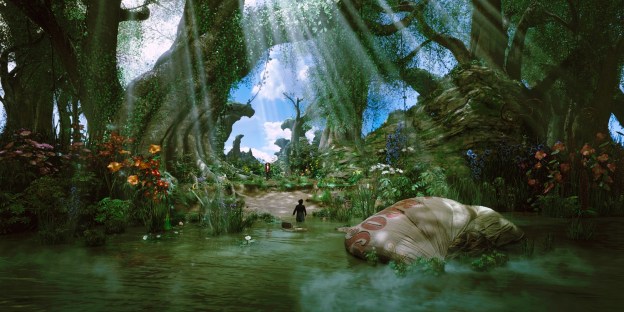 After watching Oz the Great and Powerful, the simplest way to describe the film to people familiar with director Sam Raimi’s work, the way I would define it to my friends, is that the story is very much like Army of Darkness. Just minus the humor, charm, and interesting characters. But at least it’s a very pretty movie.
After watching Oz the Great and Powerful, the simplest way to describe the film to people familiar with director Sam Raimi’s work, the way I would define it to my friends, is that the story is very much like Army of Darkness. Just minus the humor, charm, and interesting characters. But at least it’s a very pretty movie.

Raimi is obviously a fan of the concept of the land of Oz and the possibilities that it offers to a visually minded filmmaker with a $200 million budget. He is apparently also a big fan of the 1939 film starring Judy Garland, so much so that his prequel was written backwards beginning with that move and working back to ensure the characters match, which limits the path that his characters can take. That is true of all prequels, but Oz sticks with characterizations that were appropriate in the 30s but seem shallow and one-dimensional by today’s film-going standards. Plus, it forces itself into the fictional stream of that earlier film, and it does so while keeping to the 1939 morality that defined the original. There are morally good characters and there are bad, and anyone that doesn’t fit into these homogenized definitions didn’t make it to the screen. The only exception is the main character, who is often more annoying than entertaining.
It’s a contrast that Raimi has reveled in before, but that contrast follows the most traditional path imaginable, leaving us with a film with almost no surprises. But again, it’s very pretty. So there’s that.
Every scene in Oz is filled with lush color and original design. Much of it requires CGI to pull this off, as many of the scenes push the borders of imagination. In that sense, the film is a wild success. Even though the CGI seems to have its occasional off moments, and anytime you rely almost completely on CGI there will be occasional moments when nothing looks real, but the general result is a film that visually looks like no other.

From this brief description, you should already know almost the entire story, right down to the ending. It also helps to be a fan of the original – a passionate fan of the original – as the film is a slave to the 1939 movie, which often explains the stereotypical and dull way most of the characters are forced to act. Even Franco’s con man-like Oscar follows an extremely predictable path, right down to the climax. This, much like Raimi’s Army of Darkness, is the story about a man out of of his element and forced into the role of leader. But the similarities don’t end there. Both Oscar and Army of Darkness’ Ash use science against magic. Both are forced to live out a prophecy. Both have to deal with spurned lovers. Both are trapped in a land they don’t fully understand. It goes on and on. The biggest difference is that the 1992 film with a $13 million budget is better, funnier, and more original in almost every single way – with the exception of Oz’s visuals, which are swell.

While that all paints a fairly damning picture of the film, there are redeeming qualities to Oz – beyond just the impressive visuals. Oz isn’t a bad film, it’s just lazy and uninspired. That isn’t helped by Franco’s Oscar. Franco has enough charisma – just – to save the character of Oscar, who the majority of the time is annoying and often the least interesting character in a scene filled with uninteresting characters. The problem isn’t Franco, it’s more fundamental than that. The same is true of Williams’ Glinda, who is never anything more than a plot device – and a contradictory one at that. It’s never entirely clear why her character becomes subservient to Oscar despite her incredible power. That’s a minor quibble though. The major quibble is that her character is just boring. Kunis is also not helped by the plot, nor does she benefit from some bizarre makeup. She feels miscast, as if she is trying to play a character she knows she shouldn’t. She, like so many things in the film, is just wasted potential.
The only characters that really stand out are Braff’s Finely, who provides much needed comic relief, King’s China Girl, and Weisz’s Evanora, who is the most interesting character on screen in every scene she is in. Granted, the bar is low, but Weisz is fun to watch. But in general, most of the characters are just hollow character stereotypes that fill roles without any real passion or interest – the cast shows little to no heart. Perhaps that is a result of the heavy CGI use, or perhaps the script just was more of a mess than the film lets on. Regardless, the acting is suspect throughout.

Conclusion
Oz is familiar to the point of being trite, and most Raimi fans won’t be able to avoid comparing it to Army of Darkness. If they do, they will find that the earlier film is superior in most ways, especially in creativity. But while that movie enjoyed playing with conventions, this one does anything but. The visuals are the real star here and offer some nice eye candy. But the plot, much like the visuals, is more style than substance.
Oz the Great and Powerful is an inoffensive film that offers a forgettable journey through a land dripping in CGI, filled with predictable characters. It’s not the type of film most will regret seeing, but neither is it a film many will remember watching afterwards.


